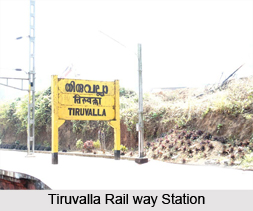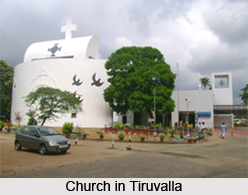 Tiruvalla is a town in Pathanamthitta District of Indian state of Kerala popular for backwaters.
Tiruvalla is a town in Pathanamthitta District of Indian state of Kerala popular for backwaters.
Location of Tiruvalla
Tiruvalla is under the Taluk headquarters located in Pathanamthitta district in the State of Kerala in South India. Tiruvalla is located at the meeting point of M C Road (Main Central Road/SH-01) and T.K. Road (Thiruvalla-Kumbazha Road) (Tiruvalla-Pathanamthitta-Kumbazha Road/SH-07/State Highway 7 (Kerala)); it links the eastern parts of the district with the western rice bowl of `Kuttanad`. The Tiruvalla-Kayamkulam road is the most used link between the National Highway and the M C Road. Tiruvalla also connects to NH-47 through the Thakazhi-Ambalappuzha Link.
History of Tiruvalla
Tiruvalla has the plenty of evidence to suggest that the area has been inhabited since 500 BCE, although an organized settlement was only founded around 800 CE. The present day areas of Niranam, and Kadapra on the western part of Tiruvalla were submerged under the sea before then. According to the mythology, Tiruvalla comes from the word "Thiru Valla Vaay", named after the river Manimala which was known as Vallayar. Tiruvalla was the mouth of river Manimala and hence was known as Valla vai. Because of this, the deity of Sri Vallabha temple was called "Thiru Vallavayappan", which later reformed as "Sri Vallabhan" Thiru Vallabha temple, which is considers the deity is the God Vishnu. The rulers of Tiruvalla belonged to the Thekkumkoor Dynasty, which had one of its headquarters at Idathil near Kaavil Temple. Idathil was the family name of the Thekkumkoor kings. Paliakara Palace is a branch of Lakshmipuram Palace of Changanacherry, which is a branch of Alikottu Kovilakam of Pazhancherry in Malabar Coast. Similarly, Nedumpuram Palace is a branch of Mavelikkara Palace, which is an heir to the Kolathiri tradition of Udayamangalam. The Thekkumkoor kings lost their control in the course of time and Vilakkili Nampoothiris were rulers in 1752-53 when Anizham Thirunaal Marthanda Varma, the king of Travancore, seized it in a bloody battle in which the ruler was killed, though some dispute was in it, saying the surrender was peaceful as the Namboothiris were not naive to challenge the mighty army of Ramayana, the shrewd and sadistic Dalava- head of administration and advisor - of Travancore. The ruins of Vilakkili illam can be seen on the side of Kavmbhagom-Muthoor road.
Geography of Tiruvalla
Tiruvalla has spread over an area of 27.94 square kilometres. Tiruvalla is on the western border of Pathanamthitta district. The municipal town limits are Thirumoolapuram, Kattod, Kaviyoor, Kuttoor, Kuttapuzha and Mepral. Formerly, some areas of present Changanacherry were parts of Tiruvalla taluk. Now the boundaries of the taluk are Varattar Bridge in the south, Parumala in the south west, Lappalam in the north, Pullad in the east and Neerattupuram in the west, situated in Alappuzha district. pullad is the last point of Tiruvalla town in the east, and it is in the Koipuram panchayat. Kollam, Thiruvananthapuram and Kochi are the nearest major cities.
 Climate of Tiruvalla
Climate of Tiruvalla
Tiruvalla has a tropical climate with temperatures ranging from highs of 34.4 degree Celsius in the summer to a low of 18.5 degree Celsius in the winter, with a healthy rainfall of 3040 mm.
Administration of Tiruvalla
Tiruvalla became a municipality in the year 1919.
Population of Tiruvalla
Tiruvalla spans a geographic area of 27.94 square kilometres with a population of 56,828 as of 2001. The males constitute 48% of the population and females 52%. In Tiruvalla, 10% of the population is under 6 years of age.
Visiting Information
The nearest airports are Cochin International Airport (105 km) and Trivandrum Airport (126 km). The proposed rural Aranmula International Airport would be the closest airport upon completion, at 18 km away.
Tourism in Tiruvalla
Tiruvalla has the pilgrimage centre of Sabarimala and is only about 100 km from Tiruvalla and Parumala Church. Paliyekara Church is a major Christian pilgrimage centre which is about 10 km from the town. The spiritual conventions at Kalloopara, Maramon, Kumbanad and Ayroor-Cherukolpuzha are all located east of Tiruvalla. Sreevallabha Temple is one of the famous Vishnu Mahakshetras of India. There is also a Chakkulathukavu Devi Temple located west of Thiruvalla thaluk. The Mar Thoma Church, the Believers Church, the St. Thomas Evangelical Church, the Indian Pentecostal Church of God (IPC) and the Sharon Fellowship Church have their headquarters in and around Tiruvalla. The headquarters of the Niranam diocese of Malankara Orthodox Church, Marthoma Church and Malankara Catholic Tiruvalla Diocese are also in Tiruvalla. The Niranam, Parumala, Paliakkara and Kallooppara churches are also common tourist destinations.



















